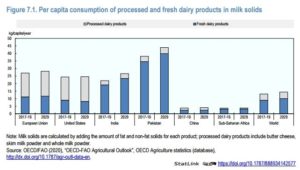World milk production (81% cow, 15% buffalo and 4% other milk sorts) will increase by 1.3% to 852 million tonnes in 2019. In the three largest producing countries (excluding India, which consumes its own production 100%), production increased only slightly, so that more milk became available for export if domestic consumption remained stable.
Click to enlarge
According to the OECD-FAO Agricultural Outlook 2020-2029, global milk production will increase by 1.6% p.a. to 997 million tonnes by 2029. India and Pakistan will account for more than half of this growth. In 2019 these countries will account for 30% of world production. EU milk production, on the other hand, will grow at a slower rate due to environmental constraints and underdeveloped domestic demand.
According to the OECD forecast, the consumption of fresh dairy products will increase worldwide by 1% p.a. until 2019. Consumption of cheese will continue to grow in North America and the EU, mainly supported by out-of-home consumption. The demand for SMP imports will grow rapidly, especially in Africa. Asia, by contrast, will show the strongest growth in demand for butter. According to the OECD, the price gap between butter and SMP will narrow compared to the last 5 years.
Click to enlarge
China remains the most important importer of dairy products, with imports set to increase by 3.6% by 2029 compared to 2020. In 2029, the three major export regions EU, New Zealand and the USA will account for around 65% of world trade in cheese, 68% of SMP, 76% of butter and 77% of SMP. According to the OECD, the EU’s share of the world cheese market is expected to rise to 44%, while New Zealand will have a share of 42% and 52% for butter and SMP respectively.
Uncertainties for the coming milk decade include the recovery of the global economy from the corona pandemic, environmental legislation and the development of the market for plant-based dairy alternatives.
The OECD expects the Russian embargo on milk products from Western countries to end this year. However, imports are likely to increase only slightly, and the trade level before the embargo will not be reached.





